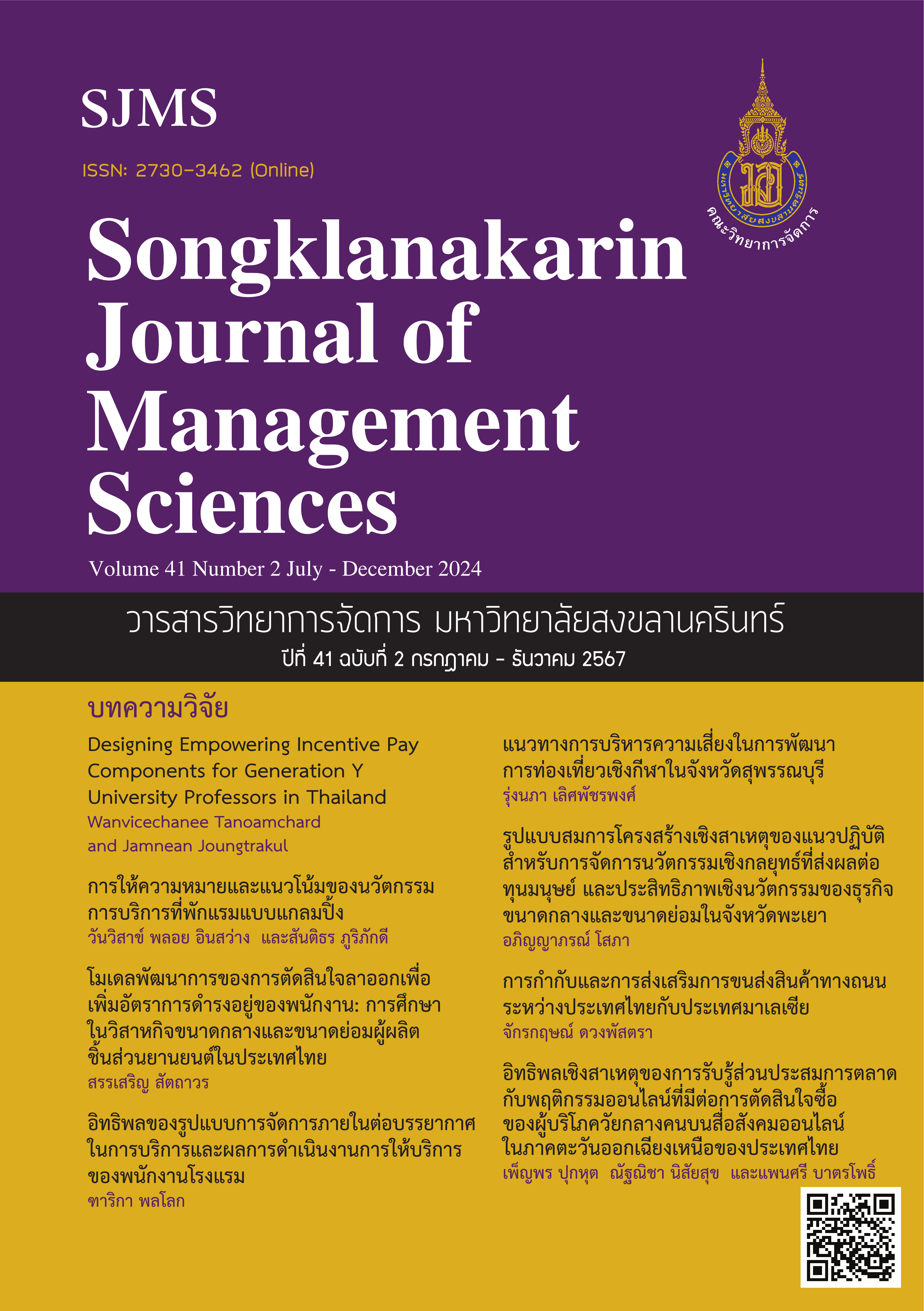Unfolding Model of Turnover for Enhancing Employees’ Retention Rate: A Study from Auto Parts Manufacturing SME in Thailand
Main Article Content
Abstract
The employee turnover research to date has tended to focus on factors affecting employees ‘turnover decisions rather than how those decisions do unfold. Based on the unfolding model of turnover, the objectives of this study are to explore the proportions of turnover decision paths among 475 permanent employees working in SME auto part manufacturers and determine the effect of the demographic attribute of gender and job tenure on their turnover decision path. The result of nonparametric analysis showed that push path has the highest proportion of turnover decision, followed by pull and planned decision path respectively. Another important finding was that proportion of decision paths are different across job tenure. Specifically, employees whose job tenure is less than one year had the highest proportion of planned, push, and pull decision path in order. In contrast, those proportions are similar regardless of gender. The findings of this study highlight a number of potential human resource management practice must be taken by the SME manufacturers such as employee survey, exit survey, and recruitment of boomerang employees in response to labor shortage and turnover problem they are experiencing in aging society.
Article Details

This work is licensed under a Creative Commons Attribution-NonCommercial-NoDerivatives 4.0 International License.
All published articles are SJMS’s copyright. The editorial board allows all published articles to be copied, excerpted, or disseminated with academic citation.
References
Chitayasothorn, D. (2008). Sex roles: A Psychological perspective. University of The Thai Chambre of Commerce Journal, 28(1), 195-208.
Holtom, B., Goldberg, C., Allen, D., & Clark, M. (2017). How today's shocks predict tomorrow's leaving. Journal of Business Psychology, 32(1), 59-71.
Jyoti. (2019). Exit interview: A way to learn from departing employees. Research Review: International Journal of Multidisciplinary, 4(2), 412-415.
Konig, C., Richter, M., & Isak, I. (2022). Exit interviews as a tool to reduce parting employees' complaints about their former employer and to ensure residual commitment. Management Research Review, 45(3), 381-397.
Kulik, C., Rae, B., Sardeshmukh, S., & Perera, S. (2015). Can we still be friends? The role of exit conversations in facilitating post-exit relationships. Human Resource Management, 54(6), 893-912.
Kulik, C., Treuren, G., & Bordia, P. (2012). Shocks and final straws: Using exit interview data to examine the unfolding model's decision paths. Human Resource Management, 51(1), 25-46.
Landis, J., & Koch, G. (1977). The measurement of observer agreement for categorical data. Biometrics, 33(1), 159-174.
Lee, T., & Mitchell, T. (1994). An alternative approach: The unfolding model of voluntary employee turnover. Academy of Management Review, 19(1), 51-89.
Lee, T., Mitchell, T., Holtom, B., McDaniel, L., & Hill, J. (1999). The Unfolding model of voluntary turnover: A replication and extension. Academy of Management Journal, 42(4), 450-462.
Ng., V., Huang, E., & Young, M. (2019). Should I stay or should I go? understanding employees' decisions to leave after mergers in Hong Kong's banking industry. Asia Pacific Journal of Management, 36(4), 1023-1051.
Pace, V. L., & Kisamore, J. L. (2017). Strategic exit interviewing: encouraging voice, enhancing alignment and examining process. Journal of Organizational Effectiveness: People and Performance, 4 (1), 59-75.
Perera, S., Sardeshmukh, S., & Kulik, C. (2015). In or out: Job exit of older workers. Asia Pacific Journal of Human Resource, 53(1), 4-21.
Shipp, A., Furst-Holloway, S., Harris, T. B., & Rosen, B. (2014). Gone today but here tomorrow: Extending the unfolding model of turnover to consider boomerang employees. Personnel Psychology, 67(2), 421-462.
Signori, P., Gozzo, I., Flint, D.J., Milfeld, T., & Nichols, B. S. (2019). Sustainable Customer Experience: Bridging Theory and Practice. In Thrassou, A., Vrontis, D., Weber, Y., Shams, S. M. R., & Tsoukatos, E. (Eds.). The Synergy of Business Theory and Practice (pp.131-174). Palgrave Macmillan, Cham.
Singh, S. (2019). A study on exit interview: Management tool to retain employees. Journal of Commerce and Trade, 14(2), 13-18.
SME. (2022). SME Entrepreneur Confidence Index. Retrieved October 21, 2023, from https://www.sme.go.th/th/search
TDRI, (2016). Human Development must come first on road towards Thailand 4.0. Retrieved August 23, 2022, from https://tdri.or.th/en/2016/10/20161022/
TDRI. (2019). SME Ranking on Non-financial data. Bangkok: The Office SME Promotion.
Tellez, R. (2014). Testing the unfolding theory of turnover: Development of an exit survey [Unpublished master’s thesis]. San Jose State University.
Thai Auto-Parts Manufacturers Association. (2022). Thaiautoparts.or.th. Retrieved August 23, 2022, from https://www.thaiautoparts.or.th/
Wararatnithikul, C. (2018). Labor force strategic development in the automotive industry and the automotive parts in Thailand. Suthiparithat, 32(104), 183-199.

